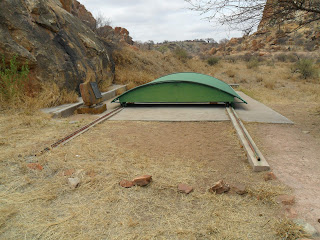Sorry I am a bit behind on my posts but as I am in the very far north of Limpopo near the Zimbabwe border, and spending most of my time in National Parks, I do not have mobile or internet connectivity much of the time. I am currently in Musina, on my way to Mapungobwe NP, sitting in a Spur restaurant having breakfast as an excuse to fire up my laptop. I am assuming also that I will be offline for the next week as I will be in Mapungobwe.
I arranged my schedule to be in Musina for the Australia v New Zealand World Cup game and picked what was advertised on line as a luxury lodge in Musina, with quite reasonable rates. Talk about false advertising! In reality it was a truck stop motel, miles out of town. No problem though as it was cheap, I saw the game (and the T20 cricket), and met some really interesting characters (pan Africa truck drivers, professional hunters, mercenaries, you get the picture of the type of place, I felt right at home).
Musina itself is an interesting place. It is the major town servicing the main border crossing into Zimbabwe, and as such it seems to have thousands of long haul trucks everywhere, waiting border clearance, a very visible SA Police and Army presence, and a lot of what appear to be migrants (illegal?) crossing the border with their worldly possessions.
Anyway, I must head. I will post again when I get a chance. Below are a few photos taken between Kruger NP and Musina.
 |
| I know, another elephant! But I like them! |
 |
| I know, another Baobab! But look at all the bird's nests. |
 |
| Not a particularly good photo, but driving through this area reminded me a lot of the Victoria River District in Australia where I was living before coming over here. Lots of rocky outcrops and Baobab trees. |
 |
| Of course the round thatched huts are not very Australian. |






















































